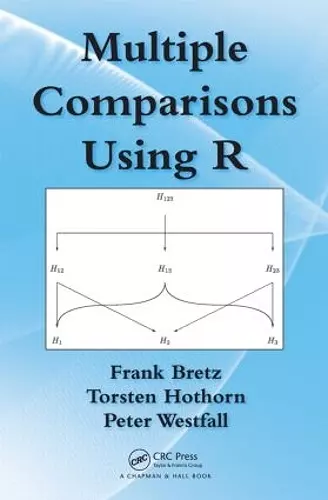Multiple Comparisons Using R
Torsten Hothorn author Peter Westfall author Frank Bretz author
Format:Hardback
Publisher:Taylor & Francis Inc
Published:27th Jul '10
Currently unavailable, and unfortunately no date known when it will be back

Adopting a unifying theme based on maximum statistics, Multiple Comparisons Using R describes the common underlying theory of multiple comparison procedures through numerous examples. It also presents a detailed description of available software implementations in R. The R packages and source code for the analyses are available at http://CRAN.R-project.org
After giving examples of multiplicity problems, the book covers general concepts and basic multiple comparisons procedures, including the Bonferroni method and Simes’ test. It then shows how to perform parametric multiple comparisons in standard linear models and general parametric models. It also introduces the multcomp package in R, which offers a convenient interface to perform multiple comparisons in a general context. Following this theoretical framework, the book explores applications involving the Dunnett test, Tukey’s all pairwise comparisons, and general multiple contrast tests for standard regression models, mixed-effects models, and parametric survival models. The last chapter reviews other multiple comparison procedures, such as resampling-based procedures, methods for group sequential or adaptive designs, and the combination of multiple comparison procedures with modeling techniques.
Controlling multiplicity in experiments ensures better decision making and safeguards against false claims. A self-contained introduction to multiple comparison procedures, this book offers strategies for constructing the procedures and illustrates the framework for multiple hypotheses testing in general parametric models. It is suitable for readers with R experience but limited knowledge of multiple comparison procedures and vice versa.
See Dr. Bretz discuss the book.
The book is primarily targeted at practitioners who will find the illustrative examples utilizing real data helpful. Methodologically interested readers are provided with interesting concepts and a good survey on multiple comparisons literature in the bibliography.
—Thorsten Dickhaus, Biometrics, September 2012
Nice stand-out features of the book are its clarity and conciseness, its coverage of group sequential and adaptive designs, and the nice illustration through actual problems using R software and the CRAN library of R routines for multiple testing. … useful for statistical consultants and graduate students who perhaps cannot afford a SAS license. … Another nice feature of the book is its organization.
—Michael R. Chernick, Technometrics, August 2011
An excellent first chapter gently explains to the reader why multiple comparison techniques are required. Successive chapters delve into more and more sophisticated scenarios for multiple comparisons. The benefits of applying multiple testing in the context of ordinary linear models are in my opinion not often stressed in undergraduate statistics courses. It was refreshing to see an entire chapter devoted to this idea. The over 150 references make this an excellent entry point into the literature … Do consider it [the book] if you are a user of R, who is also a researcher or teacher of linear modelling, and needs to apply multiple comparisons in their work. Your work will be the better for it.
—Alice Richardson, International Statistical Review (2011), 79
I found the book to be a rare gem; it is very seldom indeed that a reviewer has difficulty finding things to criticize. The book is concise, but covers all the common topics and a little more. It is simply written, yet manages to explain the key concepts remarkably well. Above all, it introduces a comprehensible structure that unifies seemingly different methodologies into a single system. … I believe this book could be useful to all those seeking guidance [on] the multitude of multiplicity correcting procedures. … The authors managed to create a fine balance between theory and practical applications … The book is warmly recommended.
—Vera Lisovskaja, Journal of Biopharmaceutical Statistics, Vol. 21, 2011
The book is primarily targeted at practitioners who will find the illustrative examples utilizing real data helpful. Methodologically interested readers are provided with interesting concepts and a good survey on multiple comparisons literature in the bibliography.
—Thorsten Dickhaus,Biometrics, September 2012
Nice stand-out features of the book are its clarity and conciseness, its coverage of group sequential and adaptive designs, and the nice illustration through actual problems using R software and the CRAN library of R routines for multiple testing. … useful for statistical consultants and graduate students who perhaps cannot afford a SAS license. … Another nice feature of the book is its organization.
—Michael R. Chernick, Technometrics, August 2011
An excellent first chapter gently explains to the reader why multiple comparison techniques are required. Successive chapters delve into more and more sophisticated scenarios for multiple comparisons. The benefits of applying multiple testing in the context of ordinary linear models are in my opinion not often stressed in undergraduate statistics courses. It was refreshing to see an entire chapter devoted to this idea. The over 150 references make this an excellent entry point into the literature … Do consider it [the book] if you are a user of R, who is also a researcher or teacher of linear modelling, and needs to apply multiple comparisons in their work. Your work will be the better for it.
—Alice Richardson, International Statistical Review (2011), 79
I found the book to be a rare gem; it is very seldom indeed that a reviewer has difficulty finding things to criticize. The book is concise, but covers all the common topics and a little more. It is simply written, yet manages to explain the key concepts remarkably well. Above all, it introduces a comprehensible structure that unifies seemingly different methodologies into a single system. … I believe this book could be useful to all those seeking guidance [on] the multitude of multiplicity correcting procedures. … The authors managed to create a fine balance between theory and practical applications … The book is warmly recommended.
—Vera Lisovskaja, Journal of Biopharmaceutical Statistics, Vol. 21, 2011
ISBN: 9781584885740
Dimensions: unknown
Weight: 460g
208 pages